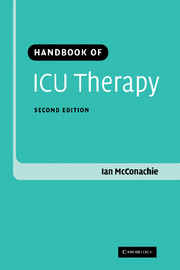Book contents
- Frontmatter
- Contents
- List of contributors
- Preface
- Part I Basic principles
- Part II Specific problems
- 17 The surgical patient in the ICU
- 18 The trauma patient
- 19 Acute coronary syndromes
- 20 Heart failure
- 21 Arrhythmias
- 22 The patient with sepsis
- 23 Acute renal failure in the critically ill
- 24 Acute lung injury and ARDS
- 25 The patient with gastrointestinal problems
- 26 The comatose patient
- 27 The critically ill asthmatic
- 28 The critically ill diabetic
- 29 The cardiac surgical patient in the ICU
- 30 Cardiac arrest
- Index
20 - Heart failure
Published online by Cambridge University Press: 24 August 2009
- Frontmatter
- Contents
- List of contributors
- Preface
- Part I Basic principles
- Part II Specific problems
- 17 The surgical patient in the ICU
- 18 The trauma patient
- 19 Acute coronary syndromes
- 20 Heart failure
- 21 Arrhythmias
- 22 The patient with sepsis
- 23 Acute renal failure in the critically ill
- 24 Acute lung injury and ARDS
- 25 The patient with gastrointestinal problems
- 26 The comatose patient
- 27 The critically ill asthmatic
- 28 The critically ill diabetic
- 29 The cardiac surgical patient in the ICU
- 30 Cardiac arrest
- Index
Summary
The prevalence of symptomatic heart failure in Europe is thought to be between 0.4% and 2.0% with the mean age being 74 years. Where the underlying problem cannot be rectified the prognosis is poor with 50% of people dead within 4 years. In patients with severe heart failure 50% will die within 1 year [1].
Acute versus chronic
Heart failure may be acute with a low cardiac output resulting in hypotension with poor organ perfusion and/or pulmonary oedema. It may also be chronic with output insufficient to provide the optimal needs of metabolizing tissues resulting in decreased tissue performance. The patient may complain of lethargy or reduced exercise tolerance.
Systolic versus diastolic
Severe heart failure is usually due to poor myocardial contractility. However the myocardium may inadequately relax resulting in reduced stretch of myocardial filaments and decreased cardiac output. This is termed diastolic heart failure and often occurs with systolic failure but may exist with the presence of a normal ejection fraction.
Aetiology
The commonest cause of heart failure in the Western world is myocardial ischaemia from coronary artery diseases. However potentially treatable and reversible aetiologies should be considered.
Cardiac
Valvular dysfunction
Arrhythmias
Hypertension
Pericardial disease.
Non-cardiac
High-output states; anaemia, pregnancy and thyrotoxicosis
Vitamin deficiencies
Alcohol
Autoimmune diseases
Infections
Drug toxicity (e.g. calcium channel blockers, beta blockers).
- Type
- Chapter
- Information
- Handbook of ICU Therapy , pp. 288 - 296Publisher: Cambridge University PressPrint publication year: 2006



